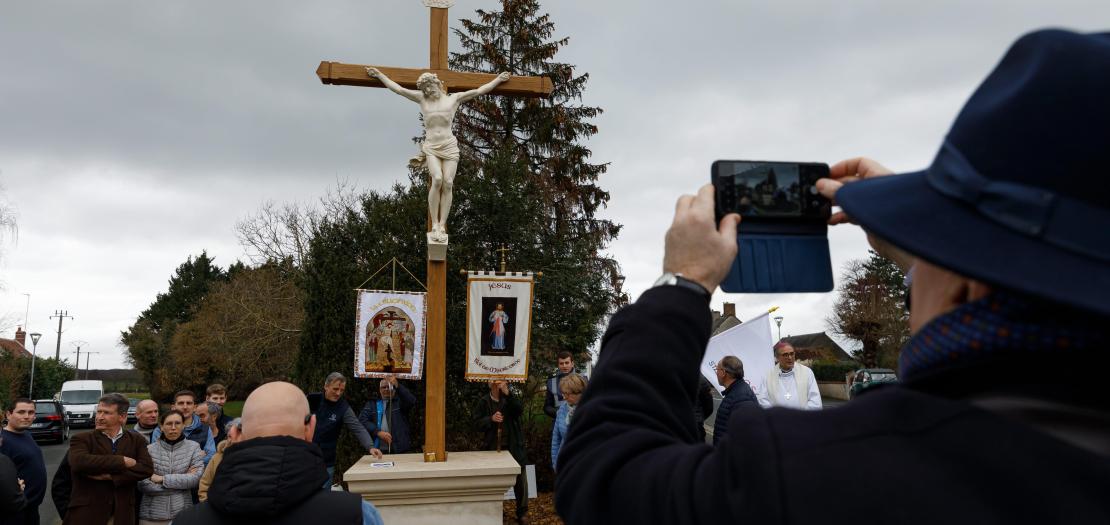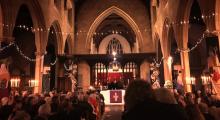Issued by the Catholic Center for Studies and Media - Jordan. Editor-in-chief Fr. Rif'at Bader - موقع أبونا abouna.org

There was a significant rise in the number of baptisms at this year’s Easter vigil in France, according to figures published before the Easter Triduum by the French National Service for Catechesis and Catechumenate.
This year at the Easter vigil, 5,463 adults received the Sacrament of Baptism across France, a 21 per cent rise on the year before. In 16 dioceses, the number of converts doubled.
The rise has been both steady and consistent. The figures revealed there were 3,639 adult baptisms in 2021, meaning 2,023 represented a 50 per cent increase on two years ago. Meanwhile, in the past 20 years, according to Le Figaro, “adult baptism requests have doubled”.
The increasing number of Catholics finding the Faith in France is from disparate backgrounds. Of those confirmed at the Easter Vigil this year, a third of those baptized were in the in the 18-25 age bracket– a proportional increase from 24 per cent two years ago. According to trends, the Church is receiving marginally more women than men into her fold.
There is a noticeably more pronounced growth in rural areas than urban areas. This year, of the 16 dioceses where adult baptisms doubled, 15 were rural. Additionally, there was only a 17 per cent increase in Paris (compared to 33 per cent nationally).
Significantly, fewer than 55 per cent of those baptised were raised in Christian families, practising and non-practising.
“The parents wanted to leave them free as children, and then in adulthood they took this step,” explained Cécile Eon, head of the National Catechesis and Catechumenate Service.
Simultaneously, on Good Friday 2023, it was reported by the Times that crucifixes were rising across France in a message that “this is a Christian country”.
A fast-growing charity named SOS Calvaires has been repairing, restoring and erecting crucifixes across the French countryside. In 2022, the charity helped raise over 200 Calvary scenes. For a long time a small local organisation after its founding in 1987, it has recently expanded rapidly and has more than 50 branches across France.
Crucifixes are not an uncommon scene in rural France. Many are historical and were built with the help of missionaries in the 18th and 19th centuries, such as St Louis Grignon de Montfort. Large metal crosses, such as the one found atop the Pic Saint-Loup in Occitania, are often found at the summit of mountains.
At Pic Saint-Loup, the nine-metre-tall and one tonne iron cross was half cut down in a spate of vandalism in 2020. The perpetrators graffitied “the secular peak” beside it. Only days later, a large wooden cross was re-erected in its place by supporters and within three months 24,000 euros had been raised and the cross was restored.
Yet despite popular support the continued existence of these religious symbols is a cause for contention.
Catholicism has historically occupied a precarious place within French society where a long political culture of laïcité (state secularism) exists. This has put Catholics in tension with prevailing ideology.
A law passed in 1905 enshrined the separation of Church and State; it also outlawed the erection of new religious symbols in public spaces.
For this reason, the government ruled after a legal battle that a statue of the Virgin Mary on the Ile de Ré, which had been placed there shortly after the Second World War, must be pulled down. A statue of Pope John Paul II in Ploërmel, Brittany was similarly ordered to be removed in 2018.
The Catholic Church in France– once termed la fille aînée de l’Église (the eldest daughter of the Church) and the country at the forefront of Christian Europe– was outlawed and harshly persecuted following the revolution in 1789. At the time, in Paris, a new religion was established known as the Cult of Reason.
In 1793, the Jacobin revolutionaries organised a public desecration of Notre Dame cathedral where the so-called female deity of “Reason” was enthroned. During the ceremony prostitutes were paid to dance on the altar and perform sexual acts inside the church.
Beginning in the same year and lasting until 1796, a Catholic loyalist revolt in the Vendée region was put down by government forces. Estimates of those killed are up to 400,000– nearly 50 per cent of the region’s population in what has been classified by historians since as a genocide.
The Church was reconciled with the government shortly after a decade at the Concordat of 1801, in which Napoleon agreed with Pope Pius VII to restore most of its civil status.
In the 19th century Catholics once again found themselves precariously placed. Having been transformed into an imperial state during the Bonapartist years (thought by opponents to be de facto and de jure little different to a monarchy) France went through multiple revolutions and regime changes.
After the Legitimists and Orléanists came close to restoring the monarchy in 1871, Catholics were associated with royalist movements and thereby perceived as a threat to the republican values popular among governing elites.
In the early 20th century, as political laïcité developed, this radicalised anti-clerical and left-wing politicians who passed the Association Law of 1901. The law banned religious associations and most of France’s ancient monasteries were forcibly shut down and seized by the State.
Among medium to large sized nations, France has the highest number of Latin Masses per capita and the second highest gross number (after the United States) in the world. Some 207 venues offer Mass in the traditional form, and it continues to see significant growth.
These figures do not account for the growth of the Society of Saint Pius X– whose founder, Archbishop Marcel Lefebvre, was French– which has a substantial and similarly growing presence with hundreds of centres including retreats, chapels, schools, churches, monasteries and hospitals across the country.
However, Catholicism in France suffered a substantial hit in the 20th century. Today, the number of citizens attending Mass weekly has been reduced to only around 5 per cent.
Amid such a weakened position in society, SOS Calvaire’s director Alexandre Caillé commented on his group’s surge in popularity and size: “I think what we’re bringing back is hope.”







